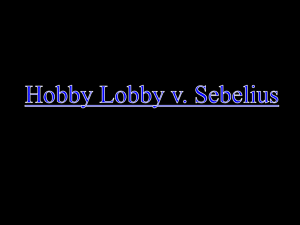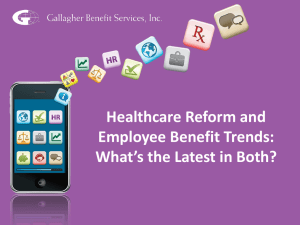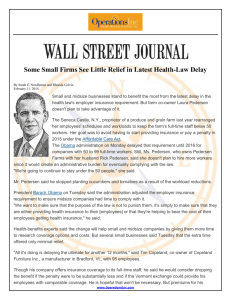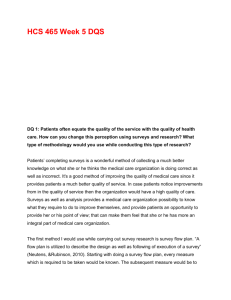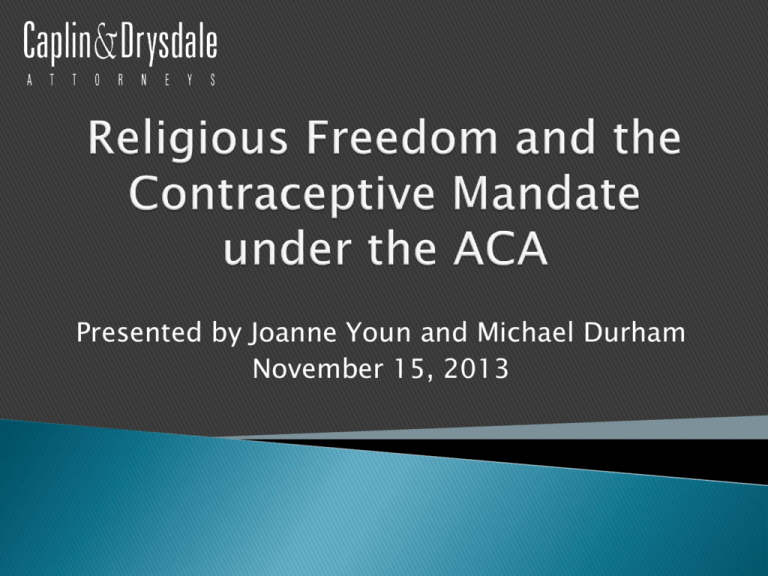
Presented by Joanne Youn and Michael Durham
November 15, 2013
Background on Religious Freedom
Restoration Act
Brief summary of “Employer Mandate” and
“Market Reform” elements of ACA
Contraceptive Mandate
Penalties
Exceptions
Proposed Legislation and Religious Freedom
Challenges
Options for Addressing the Mandate
2
First Amendment guarantees freedom of
belief but not necessarily freedom of conduct.
How do you deal with conflicts between
generally applicable laws and individual
religious conscience?
3
Employment Division v. Smith (1990)
Generally applicable laws don’t violate the Free
Exercise clause, even if they burden religious belief.
Exceptions for expressive
conduct, church autonomy
4
Congress’s attempt to “repeal” Smith decision
and require accommodation unless the
“compelling interest” test is satisfied.
Applies to all federal laws
after 1993 unless they
specifically state that
RFRA is not applicable
(ACA did not).
5
Government may substantially burden a person’s
exercise of religion only if it demonstrates that
application of the burden to the person—
(1) is in furtherance of a compelling governmental
interest; and
(2) is the least restrictive means of furthering that
compelling governmental interest.
Judicial relief provided
Government must have a compelling interest not
only in the general scheme, but also in applying
that scheme to the religious objector.
6
Patient Protection and Affordable Care Act
legislation passed March 23, 2010
Key elements include the employer mandate and
market reforms
Employer mandate
Current guidance provides that beginning in 2015,
applicable large employers—employers with 50 or more
full-time employees (including full-time equivalents)—
are subject to an annual penalty of $2,000 per full-time
employee (minus 30 full-time employees) if they fail to
offer minimum essential coverage under an eligible
employer sponsored plan (4980H(a)) to full-time
employees and their dependents, not including spouses
Penalty assessed yearly based on a monthly calculation
7
Full-time employees for applicable large
employer status
Number of full-time employees determined at controlled
group level based on previous year data
Full-time means 30 hours per week or 130 hours per
month
Full-time equivalents—divide total hours of non-fulltime employees by 120
Full-time employees for determining
coverage/calculation penalty
Different measurement periods for ongoing and new
employees; special rules for variable hour employees
Affordability and minimum value requirements
8
Common control for tax-exempt organizations, generally
Additional rule in Notice 89-23 for churches and qualified
church-controlled organizations (defined in 3121(w)(3))
Common control if 80% of the directors or trustees of one
organization are either representatives of, or directly or indirectly
controlled by, the other organization
Common control if one organization provides 80 percent of
another organization’s operating funds and there is a degree of
common management or supervision between the organizations
Proposed regulations reserve on the applicability of the
controlled group aggregation rules to government entities,
churches or convention associations of churches
Good faith standard until further guidance
Anti-abuse rules
9
Market reforms effective for plan years beginning
on or after September 23, 2010
Coverage of certain dependents until age 26
Prohibition on lifetime limits on essential health benefits
Restriction on annual limits on essential health benefits
Appeals process and external review requirements
Prohibition on pre-existing condition exclusions for
those under age 19
Prohibition on rescissions (retroactive terminations of
coverage)
Patient protections (primary care provider designations,
direct access to obstetrical and gynecological care,
emergency services)
10
Market reforms effective for plan years beginning on
or after January 1, 2014
Prohibition on annual limits on essential health benefits
Prohibition on pre-existing condition exclusions for all
Required coverage of clinical trials
Required essential health benefits package (for individual
and small group insured plans)
Prohibition on excessive waiting periods
Premium rating limitations
Guaranteed availability and renewability
Nondiscrimination against health care providers
Nondiscrimination based on health status (extended to
individual coverage)
Deductible limits (for small group insured plans)
Out-of-pocket limits
11
Certain market reforms have different
applicable dates, including PHSA § 2713(a)
(preventive services coverage).
Specifically, PHSA § 2713(a)(4) requires
coverage with no cost-sharing for
with respect to women, such additional preventive
care and screenings as provided for in
comprehensive guidelines supported by the Health
Resources and Services Administration (“HRSA”) for
purposes of this paragraph.
12
13
Excise tax liability for failure to comply with
market reforms (4980D)
$100 per day “with respect to each individual to
whom such failure relates”
Penalty assessed for each day until the failure is
corrected
Self-assessed on Form 8928; failure to file can
result in interest.
14
Exceptions and limitations on 4980D penalty:
if due to reasonable cause and not willful neglect,
• No penalty if cured within 30 days of discovery (or, for
church plans, within 270 days of IRS finding a
violation)
• penalty capped at $500,000 per year, and may be
waived.
Small employers that provide health insurance
coverage solely through a contract with a health
issuer may avoid penalty if violation is solely due to
health insurer’s lapse.
15
Exceptions and limitations on 4980D penalty:
if due to reasonable cause and not willful neglect,
• No penalty if cured within 30 days of discovery (or, for
church plans, within 270 days of IRS finding a
violation)
“Ordinary business care” standard
• penalty capped at $500,000 per year, and may be
Normally, intentional violations don’t qualify
waived.
Smallemployers
that
provide
health
insurance
But reasonable
cause
may exist
if written
advice
coverage
solely
through
a contract
from a
qualified
professional
indicateswith
that a health
doesn’t
apply.
issuerrequirement
may avoid
penalty
if violation is solely due to
health insurer’s lapse.
At least one case has found reasonable cause
because of a good faith RFRA claim.
16
$6,000,000
$5,096,000
$5,000,000
$4,000,000
4980D
$3,000,000
Reasonable Cause
$2,555,000
$2,000,000
4980H
$1,000,000
$1,000,000
$500,000
$80,000
$160,000
$1/1/2014
1/1/2015
17
HRSA guidelines issued August 1, 2011—applicable
for plan years beginning on or after August 1, 2012
Regulations authorize a “religious employer”
exemption, definition was modified effective
August 1, 2013
Temporary enforcement safe harbor for some
employers effective until plan years beginning on or
after January 1, 2014, at which time “eligible
organization” accommodation is available
18
Does not apply to grandfathered plans
Employers with less than 50 full-time employees
Plans that were in existence on March 23, 2010 that
have not undergone significant changes since that date
Includes full-time equivalents
Controlled group level
Do not have to offer coverage
Not actual exception to contraceptive mandate
• Must comply with contraceptive mandate if coverage is
offered
“Religious employer” exemption and “eligible
organization” accommodation
Interpreted by the government to apply employer-byemployer
19
Although previously more narrowly defined,
the current definition of “religious employer,”
effective August 1, 2013, is simply
An employer that is organized and operates as a
nonprofit entity and is a church, integrated
auxiliary, convention or association of churches, or
the exclusively religious activities of any religious
order
20
“Eligible organization”
(1) Opposes providing some or all of the
contraceptive services required to be covered by the
mandate on account of religious objections
(2) Organized and operates as a nonprofit entity
(3) Holds itself out as a religious organization
(4) Self-certifies that it satisfies the criteria in items
(1) through (3) – form available on DOL website
21
Accommodation for fully insured plans
Accommodation for self-insured plans
Provide self-certification to insurance issuer
Insurance issuer provides separate payments for
contraceptive services without cost on the plan or
participants
Provide self-certification to third party administrator
(“TPA”)
TPA becomes “plan administrator” with respect to
contraceptive services
TPA must provide separate payments or arrange for
separate payments for contraceptive services
Reimbursement through adjustment to federal exchange
user fees
22
Disagreement About the Accommodation
Catholic Health Association initially expressed
concerns about the mandate, but has accepted the
accommodation as a reasonable compromise
U.S. Conference of Catholic Bishops continues to
believe that the accommodation is inadequate to
address the 1st Amendment concerns of religious
employers and notes that it does not provide any
protection for for-profit businesses that oppose the
mandate
23
Numerous law suits (Becket Fund counts 75+)
Many religious organizations’ cases were dismissed
or held in abeyance until final rules came out, but
are now being refiled
Preliminary injunctions granted in a clear majority
of for-profit cases
• Already lots of exceptions—why not one more?
• Most influential reason for denying injunction is that
for-profit business can’t exercise religion.
24
Preliminary
injunction wins
in 10th, 8th, 7th ,
and D.C. circuits
(9th circuit has
some favorable
precedent)
Preliminary
injunction losses
in 3rd and 6th
circuits
25
Standing: religious organizations more likely to be held
capable of “exercising religion.”
Religious orgs. can raise church autonomy claims
Government accommodation strengthens its argument
that it has infringed religious freedom no more than
necessary.
But new exception for religious employers also suggests
that exceptions are manageable, so why not one more.
Church groups are arguing that the new rules
distinguishing between integrated auxiliaries and other
religious nonprofits violate the establishment clause.
What are considered exclusively religious activities of a
religious order? Can government draw these distinctions?
26
Proposed legislation
Repealing the Affordable Care Act
Changing definition of full-time employees
Delaying employer mandate further
Exempting certain types of employers (e.g.,
educational institutions) from employer mandate
Creating broader religious exceptions to
contraceptive mandate
Limiting application of HRSA guidelines?
27
PHSA § 2713 limits other preventive services
requirements
Coverage without cost-sharing required for “evidencebased items or services that have in effect a rating of “A”
or “B” in the current recommendations of the United
States Preventive Services Task Force”
Certain recommendations excluded by the statute—“for
the purposes of this Act, and for the purposes of any
other provision of law, the current recommendations of
the United States Preventive Service Task Force regarding
breast cancer screening, mammography, and prevention
shall be considered the most current other than those
issued in or around November 2009.”
28
For now, take the position that RFRA precludes
the contraception coverage requirement
Viability may depend on jurisdiction
Also may depend on breadth of violation and record of
religious opposition
Nontrivial risk of penalties, particularly if Supreme Court
resolves RFRA claims adversely.
Consider taking steps to limit penalty exposure by
establishing “reasonable cause”
In the interim, organization may need to file Form 8928
29
Establish/shore up integrated auxiliary status
Must be a 501(c)(3) and a public charity – standards
have changed, especially for 509(a)(3) orgs
Must meet an affiliation test:
•
•
•
•
Majority control;
Another 509(a)(3) relationship
group ruling
or facts and circumstances.
Must be internally supported
Consider getting an IRS ruling or legal opinion
30
Establish / shore up integrated auxiliary
status
Must be “internally supported,” meaning that
EITHER:
• It does not offer admissions, goods, services, or
facilities for sale, other than incidentally, to the
general public (unless charges are nominal or an
insubstantial portion of cost), OR
• It does not receive more than 50% of its support from:
governmental sources,
public solicitation of contributions,
receipts from the mission-related sale of admissions,
goods, performance of services, or provision of facilities.
31
Two Paths to Internal Support & Integrated Auxiliary Status
Option 1: Face Inward
Option 2: Keep “bad” support < 50%
• No admissions, goods, services,
or facilities for sale to the public
except incidentally
Gov’t
funding
Public
solicitations
• Exception if charge is nominal
or an insubstantial portion of the
cost.
More than 50%
•UBTI
Mission-related
fees, sales,
rentals
• Investments
• Royalties
• Church gifts
• Other income?
Must total below
50% of support
32
Strategies for attaining integrated auxiliary
status
Explore increasing other kinds of revenue
• donations from the church / affiliates / members
• Investment income,
• UBIT, royalties, etc.
Could more support come through church?
Where are endowments or other large revenue
streams held?
Merge in for-profit subsidiaries?
But remember liability concerns
33
Accept accommodation
Self-certification triggers obligation of insurer or
third-party administrator to provide benefits; may
authorize TPA to do so as a plan administrator.
Groups may have sincere differences about whether
accommodation still leaves them involved in
providing contraception or facilitating abortion
Groups with multiple subsidiaries should take care
regarding their for-profit subsidiaries, which may
not be eligible for the exemption.
34
Stop providing health plans altogether
For applicable large employers, this would avoid
4980D penalties but result in smaller penalties
under 4980H
Depending on degree of control, employers in a
church group may not have to aggregate with other
entities in the system, and may each separately
qualify as small employers.
What options are there for employees not covered
by their employer?
35
Joanne C. Youn
jyoun@capdale.com
(202) 862-7855
Michael W. Durham
mdurham@capdale.com
(202) 862-5031
______________________________________________
Disclaimer
This communication does not provide legal advice, nor does it create an attorney-client relationship with you or any other reader. If you require legal guidance in any specific
situation, you should engage a qualified lawyer for that purpose. Prior results do not guarantee a similar outcome.
Attorney Advertising
It is possible that under the laws, rules, or regulations of certain jurisdictions, this may be construed as an advertisement or solicitation.
© 2013 Caplin & Drysdale, Chartered
All Rights Reserved.
36


